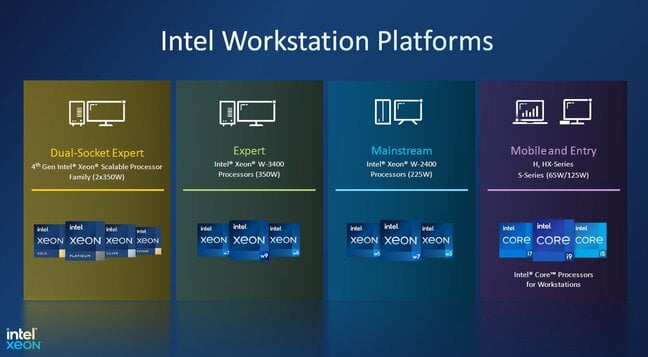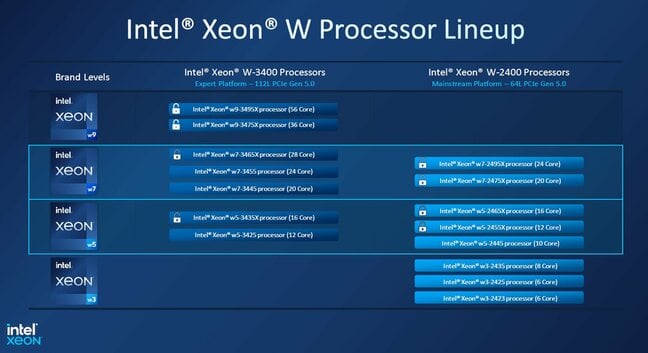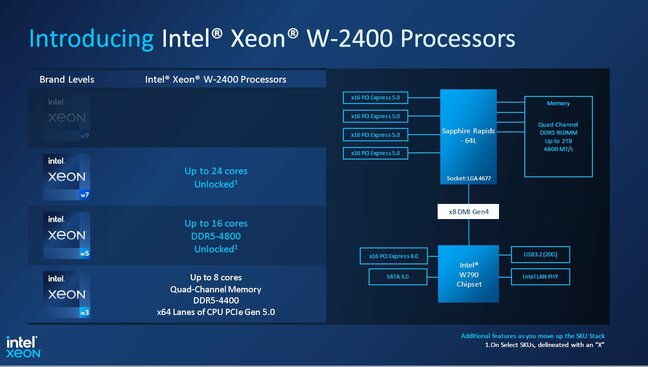Intel Sapphire Rapids Workstation Chips Tout Up To 56 Cores And Unlocked SKUs
Intel has officially launched the workstation-focused versions of its Sapphire Rapids Xeon processors, claiming an almost 30 percent boost in performance per core users when compared to its previous platform.
The latest updates to the Intel Xeon W processor portfolio, the new chips are based on the same technology as the 4th Generation Xeon Scalable server family the chipmaker introduced last month.
These latest workstation parts are available for pre-order immediately, Intel said, with system availability coming in March from vendors such as Dell, HP, Lenovo and Supermicro.
At launch, the new chips are split into two families, the Xeon W-3400 line and the Xeon W-2400 line, with the latter aimed at mainstream workstation systems and the former targeting higher-end systems, or what the chipmaker has dubbed expert workstations.
However, those don't represent the peak of Intel's workstation portfolio, which is filled by systems based on the Xeon Scalable platform, dubbed dual-socket expert, while Intel Core chips will form the entry and mobile level (Intel said it will disclose more on the latter this quarter).
The differences between the Xeon W-3400 expert chips and the Xeon W-2400 mainstream chips lie in the maximum number of cores, DDR5 memory channels and PCIe 5.0 lanes available in each.
Both of these are further divided up into w9, w7, w5 and w3 sub-brands, such that w9 chips only feature in the Xeon W-3400 expert family, and w3 chips are only found in the Xeon W-2400 family. Got that?
The Xeon W-3400 tops out at 56 cores for the w9 chips, 28 cores for w7 and 16 cores for w5. All of these feature 8 memory channels for up to 4TB of DDR5-4800 DRAM, plus 112 PCIe 5.0 lanes which allows for up to 28 storage devices or up to 7 GPUs to be connected.
For the Xeon W-2400 family, these have up to 24 cores for the w7 chips, 16 for w5 and up to 8 cores for w3. All of this family feature 64 lines of PCIe 5.0 for up to 16 storage devices or 4 GPUs, and 4 memory channels for up to 2TB of DDR5-4800 DRAM. The exception is the w3 SKUs which only support DDR5-4400.
The W790 motherboard chipset, common to both families, provides a further 16 PCIe 4.0 lanes, up to 8 SATA ports, up to 5 USB 3.2 ports, plus integrated Wi-Fi 6E and 2.5Gbps Ethernet port.
- Intel inside a world of pain as revenue plunges by a third
- Intel chairman exits just ahead of next financial report
- Years late and 36 cores short of AMD, who are Intel's 4th-gen Xeons even for?
- After long delays, Sapphire Rapids arrives, full of accelerators and superlatives
Some of the new Xeon W processors are also unlocked, enabling highly specialized workload tuning, according to Intel. These chips are denoted by an "X" at the end of the processor number.
"While most workstation users prioritize stability and reliability for those mission critical workflows, we recognise that there are a group of users out there who value performance above all else and want the choice to tune their processor to meet their needs," said Intel Workstation Platform Manager Zac Kranich.
"For those individuals, these unlocked SKUs will give the users the options for tuning per core frequency and voltage control, negative offset ratio tuning for AVX as well as the new AMX instructions."
Tuning even extends to the ability to adjust the frequency of the interconnects between the cores and tiles inside the chip package, he claimed, via an Intel Extreme tuning utility.
According to Intel, these new Xeon W processors provide a performance boost simply by enabling core counts (up to 56) in a single-socket workstation that would have previously required a twin-socket configuration. Clock speeds can also go up to 4.8GHz with Intel Turbo boost Max 3.0.
To put figures to those numbers, Intel claims that the new platform delivers up to 140 percent more performance than the previous generation, at least as measured by the SPECworkstation 3.1 benchmark.
Intel also claims 70 percent greater performance for workloads such as modelling, simulation and visualization, and up to a 75 percent boost in performance for scientific computing and analysis, although the performance customers see will obviously depend on their specific application and workload.
The chip giant said there are over 50 new workstation designs powered by the latest Xeon W processors in the pipeline, hailing the launch as "a major milestone."
The recommended customer price for the Xeon W Processor family starts at $359 (Xeon w3-2423) and scales up to $5,889 (Xeon w9-3495X), Intel told us. Details on specific system availability will be coming from system vendors in the coming weeks. ®
From Chip War To Cloud War: The Next Frontier In Global Tech Competition
The global chip war, characterized by intense competition among nations and corporations for supremacy in semiconductor ... Read more
The High Stakes Of Tech Regulation: Security Risks And Market Dynamics
The influence of tech giants in the global economy continues to grow, raising crucial questions about how to balance sec... Read more
The Tyranny Of Instagram Interiors: Why It's Time To Break Free From Algorithm-Driven Aesthetics
Instagram has become a dominant force in shaping interior design trends, offering a seemingly endless stream of inspirat... Read more
The Data Crunch In AI: Strategies For Sustainability
Exploring solutions to the imminent exhaustion of internet data for AI training.As the artificial intelligence (AI) indu... Read more
Google Abandons Four-Year Effort To Remove Cookies From Chrome Browser
After four years of dedicated effort, Google has decided to abandon its plan to remove third-party cookies from its Chro... Read more
LinkedIn Embraces AI And Gamification To Drive User Engagement And Revenue
In an effort to tackle slowing revenue growth and enhance user engagement, LinkedIn is turning to artificial intelligenc... Read more





